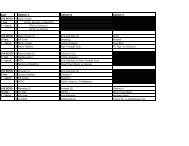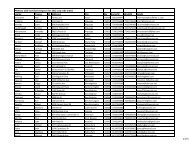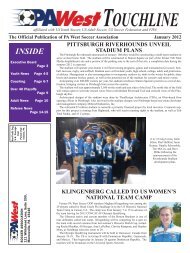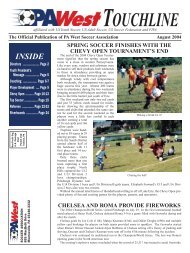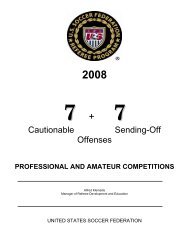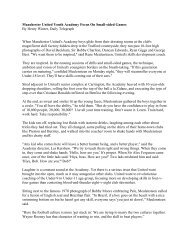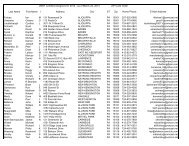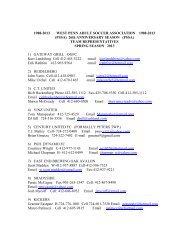RECERTIFICATION - PA West Soccer Association
RECERTIFICATION - PA West Soccer Association
RECERTIFICATION - PA West Soccer Association
You also want an ePaper? Increase the reach of your titles
YUMPU automatically turns print PDFs into web optimized ePapers that Google loves.
UNITED STATES SOCCER FEDERATION<br />
EXAMINATION<br />
2010 - 2011<br />
REFEREE GRADE 9<br />
Paul Tamberino, Director of Referee Development<br />
Alfred Kleinaitis, Manager of Referee Development & Education
Instructions: Answer the questions that follow, according to the Laws of the Game, effective July<br />
1, 2010, and to the instructions given in the current edition of the USSF publication, Guide to<br />
Procedures for Referees, Assistant Referees and Fourth Officials, as well as Advice to Referees.<br />
Unless stated otherwise, questions apply to full-sided games.<br />
In answering the following questions, select the BEST response.<br />
1. The referee and assistant referees are expected to be at the field at least 30 minutes prior to kick off<br />
in order to inspect the field and have a pre-game talk.<br />
a. True b. False<br />
2. The referee should inspect the ball to make sure that it meets the requirements of Law 2.<br />
a. True b. False<br />
3. A team may choose to play without a goalkeeper.<br />
a. True b. False<br />
4. A goal may be scored directly from a corner kick.<br />
a. True b. False<br />
5. A goal should be awarded if, after an indirect free kick taken by a member of the attacking team, the<br />
ball bounces off the goal post, hits a defender's leg, and then goes into the goal,.<br />
a. True b. False<br />
6. At the taking of a corner kick, opponents are required to be 10 yards from<br />
a. the ball<br />
b. the corner flag<br />
c. the player taking the corner kick<br />
d. the corner arc<br />
e. the touchline<br />
7. According to Law 1, the correct terms for the boundary lines around the field are called<br />
a. end lines and side lines<br />
b. goal lines and touch lines<br />
8. Which is true about the penalty area?<br />
a. it shows where the goalkeeper can handle the ball.<br />
b. direct free kick fouls committed by a defender within it are punished by a penalty kick.<br />
c. all free kicks taken by the defending team must clear the penalty area, into the field of play,<br />
before the ball is in play.<br />
d. all of the above.<br />
9. When a penalty kick is taken, all players except the kicker and goalkeeper must be<br />
a. outside the penalty area.<br />
b. behind the ball.<br />
c. on the field of play (except players off the field of play with the permission of the referee).<br />
d. all of the above.<br />
10. Players are allowed to wear jewelry as long as it is properly taped.<br />
a. True b. False<br />
11. How many players are there on a full-sided soccer team that is ready to play?<br />
a. 6. b. 12. c. Maximum of 11.<br />
U.S. <strong>Soccer</strong> Federation Recreational Referee Examination 2010 – 2011 Page 2
12. At the taking of a throw-in, all opponents must stand at least 2 yards away from the point at which the<br />
throw-in is taken.<br />
a. True b. False<br />
13. A goalkeeper, while punting the ball from the top of the penalty area, goes completely out of the<br />
penalty area and into the penalty arc while in control of the ball with his/her hands. The referee should<br />
a. award an indirect free kick just outside the penalty area.<br />
b. award a direct free kick just outside the penalty area.<br />
c. award a penalty kick.<br />
14. Which requirement applies to players' shoes?<br />
a. They must be soccer shoes.<br />
b. They must be made of leather.<br />
c. They must not be dangerous to other players.<br />
15. Which statement about players' equipment is more accurate?<br />
a. Players must wear shin guards.<br />
b. Players must wear shin guards entirely covered by their socks.<br />
16. An under-14 match is played in<br />
a. 2 halves of 35 minutes each. b. 4 quarters of 17 minutes each.<br />
17. The winner of the coin toss before the game<br />
a. kicks off. b. has the choice of which goal to attack.<br />
18. On a kick-off<br />
a. opponents must be 10 yards from the ball (less for under 6, 8, 10).<br />
b. all players must be in their own half.<br />
c. the ball must be kicked forward.<br />
d. all of the above.<br />
19. The game should be restarted with a dropped ball when you have stopped play because of<br />
a. injury b. interference by a parent, dog, or coach<br />
c. lightning (when safe to restart) d. any of the above<br />
20. When is the ball out of play?<br />
a. When any part of the ball is over the goal line or touch line.<br />
b. When the whole ball is completely outside the goal line or touch line.<br />
c. When most of the ball is over the goal line or touch line.<br />
21. If the ball hits the referee and stays inside the field<br />
a. it is still in play. b. it is out of play.<br />
22. A player taking a throw-in must have both feet<br />
a. on the ground. b. on or outside the touch line. c. both a and b<br />
23. For safety reasons, goals MUST be anchored securely to the ground.<br />
a. True<br />
b. False<br />
U.S. <strong>Soccer</strong> Federation Recreational Referee Examination 2010 – 2011 Page 3
24. A player gets hit in the face with a kicked ball and you see that he/she has a bloody nose. You should<br />
a. keep playing until a convenient time to stop, then have him/her treated.<br />
b. stop the game and have the player taken off the field and treated. Substitutions are allowed.<br />
25. If the ball does not go outside the penalty area at the taking of a goal kick, you should<br />
a. allow any player to kick the ball. b. have the team retake the goal kick.<br />
26. A corner kick is taken from<br />
a. inside the corner arc nearest where the ball went over the goal line.<br />
b. inside the corner arc on either side of the field.<br />
27. To award a direct free kick, the foul must be committed<br />
a. on the field while the ball is in play.<br />
b. by a player against an opponent (except handling the ball).<br />
c. both of the above.<br />
28. A player commits a charging foul in a manner that you consider reckless. When you caution (yellow<br />
card) that player, you should caution him/her for unsporting behavior.<br />
a. True b. False<br />
29. Midway through the second half, you see lightning near the field. The coaches of both teams wish<br />
to continue the game. The referee should<br />
a. continue the game.<br />
b. suspend the game, regardless of the coaches’ opinions, and find shelter immediately.<br />
30. To score a goal on an indirect free kick, the ball must be touched by the kicker and<br />
a. only a teammate of the kicker. b. any player from either team, other than the kicker.<br />
31. When an indirect free kick is taken outside the penalty area, the ball is in play when it is kicked and<br />
moves.<br />
a. True b. False<br />
32. When a player in his/her own goal area commits a foul punishable by an indirect free kick, the restart<br />
is an indirect free kick from the spot of the foul.<br />
a. True b. False<br />
33. A player is taking a penalty kick. His/her teammate runs into the penalty area before the ball is kicked<br />
and the ball is kicked wide of the goal. You award<br />
a. a retake of the penalty kick. b. a goal kick. c. a corner kick. d. an indirect free kick.<br />
34. Penalty kicks<br />
a. are not used in under-6 and under-8 small-sided games.<br />
b. must be taken by the player who is fouled.<br />
c. all of the above.<br />
35. To be in an offside position, a player must be<br />
a. nearer to the opponent’s goal line than the ball.<br />
b. nearer to the opponent’s goal line than the second-to-last defender.<br />
c. both a and b.<br />
U.S. <strong>Soccer</strong> Federation Recreational Referee Examination 2010 – 2011 Page 4
36. A player is in an offside position. He/she does not interfere with play or with an opponent and does not<br />
gain an advantage while in that position.<br />
a. You call him/her offside and give an indirect free kick to the opponents.<br />
b. You allow play to continue and do not call him/her offside.<br />
37. A player, who is not in an offside position when the ball is played forward, runs into an offside position<br />
to receive the ball. He/she should<br />
a. be called offside. b. not be called offside.<br />
38. A player cannot be punished for being offside if he/she receives the ball directly from a<br />
a. direct free kick. b. indirect free kick. c. corner kick.<br />
39. The assistant referee's normal position during the game, when the ball is in play, is even with<br />
a. the second-to-last defender.<br />
b. the ball.<br />
c. whichever of the two above is closer to the goal line.<br />
40. The official time of the game is kept by the<br />
a. coach of the home team. b. assistant referees. c. referee.<br />
41. A written report must be completed by the referee, including<br />
a. each caution and send-off.<br />
b. bad behavior by a coach.<br />
c. both of the above.<br />
42. After a goal is scored, the signal by the assistant referee is to<br />
a. point to the center circle with the flag.<br />
b. run up the touch line toward the halfway line.<br />
43. When the referee blows the whistle for a foul, he/she should<br />
a. stand at the spot for the free kick.<br />
b. point in the direction the kicking team is attacking.<br />
For questions 44 through 50, play is stopped for the reason that is listed. Identify in each case<br />
how play should be restarted.<br />
44. A player is seriously injured<br />
a. direct free kick<br />
b. indirect free kick<br />
c. dropped ball<br />
45. Pushing an opponent, on the field of play, while the ball is in play, considered by the referee to be<br />
done in a carelessly, recklessly, or using excessive force.<br />
a. direct free kick<br />
b. indirect free kick<br />
c. dropped ball<br />
46. Goalkeeper holding the ball with his/her hands for more than six seconds<br />
a. direct free kick<br />
b. indirect free kick<br />
c. dropped ball<br />
U.S. <strong>Soccer</strong> Federation Recreational Referee Examination 2010 – 2011 Page 5
47. Tripping an opponent, on the field of play, while the ball is in play, considered by the referee to be<br />
done in a carelessly, recklessly, or using excessive force.<br />
a. direct free kick<br />
b. indirect free kick<br />
c. dropped ball<br />
48. Kicking the ball when it is dangerously close to an opponent's face<br />
a. direct free kick<br />
b. indirect free kick<br />
c. dropped ball<br />
49. Holding an opponent, on the field of play, while the ball is in play.<br />
a. direct free kick<br />
b. indirect free kick<br />
c. dropped ball<br />
50. Goalkeeper handling a ball inside the penalty area that is legally thrown in by a teammate<br />
a. direct free kick<br />
b. indirect free kick<br />
c. dropped ball<br />
U.S. <strong>Soccer</strong> Federation Recreational Referee Examination 2010 – 2011 Page 6
USSF Exam Answer Sheet<br />
Name:<br />
1 26 51 76<br />
2 27 52 77<br />
3 28 53 78<br />
4 29 54 79<br />
5 30 55 80<br />
6 31 56 81<br />
7 32 57 82<br />
8 33 58 83<br />
9 34 59 84<br />
10 35 60 85<br />
11 36 61 86<br />
12 37 62 87<br />
13 38 63 88<br />
14 39 64 89<br />
15 40 65 90<br />
16 41 66 91<br />
17 42 67 92<br />
18 43 68 93<br />
19 44 69 94<br />
20 45 70 95<br />
21 46 71 96<br />
22 47 72 97<br />
23 48 73 98<br />
24 49 74 99<br />
25 50 75 100



